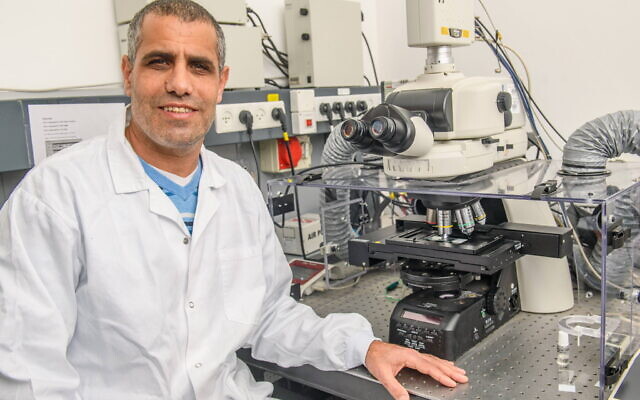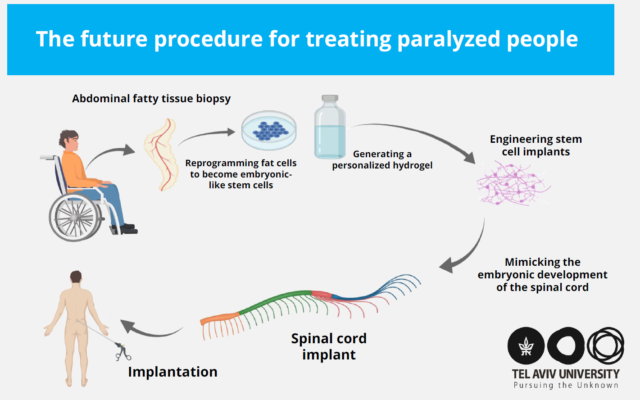Israeli scientists have made paralyzed mice walk by giving them spinal cord implants, and say they are less than three years away from doing the same for humans in clinical trials.
The world-first experiment took place at Tel Aviv University, where a large team engineered spinal cord tissue from human cells, and implanted them into 15 mice with long-term paralysis. Twelve of the mice then walked normally, the scientists revealed on Monday in newly peer-reviewed research published in the journal Advanced Science.
“If this works in humans, and we believe that it will, it can offer all paralyzed people hope that they may walk again,” Prof. Tal Dvir’s research team at the Sagol Center for Regenerative Biotechnology told The Times of Israel, adding that discussions regarding clinical trials have been opened with America’s Food and Drug Administration.
He said that while all his mice received spinal implants from cells of three people, if the innovation is deployed in humans, the plan is to grow a unique spine for each patient using cells from their own body.
Dvir predicts this will “enable regeneration of the damaged tissue with no risk of rejection,” and it will eliminate the need to suppress the immune systems of recipients, as happens in the case of many transplants.
“There are millions of people around the world who are paralyzed due to spinal injury, and there is still no effective treatment for their condition,” Dvir said.
“People injured at a very young age are destined to sit in a wheelchair for the rest of their lives, bearing all the social, financial, and health-related costs of paralysis. We hope to solve this and help them to walk.”

A young woman lying in a hospital bed after a serious accident (iStock via Getty Images)
To date, some scientific teams have conducted experiments producing human-based stem cells and injecting them into the spinal cords of animals. But Dvir said this is the first lab to grow pieces of actual spine engineered from human cells, and transplant them.
Another unique factor in his research is its treatment of long-paralyzed animals, as the stem cell studies tend to have tended to limit themselves to newly paralyzed animals.
“Realistically, most humans needing treatment will have been paralyzed for some time when treatment is wanted, so this is important,” said Dvir. “In our experiment, we used both newly paralyzed and long-paralyzed mice. We had success with both, and expect the impact to work with humans who have been paralyzed for different amounts of time.”

Prof. Tal Dvir (courtesy of Tel Aviv University)
He added that while the success rate with his spinal cord was 80% for mice with chronic paralysis, among those with recent or short-term paralysis, 100% of mice walked.
Dvir said that the process starts with a small biopsy from the belly.
“We separate the fat cells from other materials such as collagen and sugars, and reprogram the cells using genetic engineering methods, so they can ‘become’ any cell in the body,” he explained.
“We put the cells in a substance that we make from the non-cellular material from the fat tissue gathered in the biopsy, put the cells inside it for 30 days, and we mimic how a spinal cord develops in an embryo. This produces spinal cord micro-neuron tissue, which we transplant into animals that have been paralyzed for a long time.”

An illustration by Tel Aviv University researchers of how they expect to implement their spinal cord implants in humans (iStock via Getty Images)
Dvir said that a company, Matricelf, has been formed to bring the technology to clinical trials, and he expects this to happen within two and a half years. He stressed that while the experiment so far involved mice, the implants were grown from humans cells, meaning that the research is already at an advanced stage.
“We’ve been using human implants on the mice, not mice implants, which means we’re not going back to the beginning of research to move over to humans. Rather, we know how to prepare the implants for humans, which is what makes us optimistic we will move quickly to clinical trials,” he said.
His team, which includes Lior Wertheim, Dr. Reuven Edri, and Dr. Yona Goldshmit, believes that the new method has relevance beyond spinal injury, and are now exploring using it for a range of other diseases and injuries, such as Parkinson’s disease, brain trauma, myocardial infarction, and age-related macular degeneration.
The Climate Crisis and Responsible Journalism
![]()
As The Times of Israel’s environment reporter, I try to convey the facts and science behind climate change and environmental degradation, to explain – and critique – the official policies affecting our future, and to describe Israeli technologies that can form part of the solution.
I am passionate about the natural world and disheartened by the dismal lack of awareness to environmental issues shown by most of the public and politicians in Israel.
I’m proud to be doing my part to keep Times of Israel readers properly informed about this vital subject – which can and does effect policy change.
Your support, through membership in The Times of Israel Community, enables us to continue our important work. Would you join our Community today?
Thank you,
Sue Surkes, Environment Reporter
You’re serious. We appreciate that!
We’re really pleased that you’ve read X Times of Israel articles in the past month.
That’s why we come to work every day – to provide discerning readers like you with must-read coverage of Israel and the Jewish world.
So now we have a request. Unlike other news outlets, we haven’t put up a paywall. But as the journalism we do is costly, we invite readers for whom The Times of Israel has become important to help support our work by joining The Times of Israel Community.
For as little as $6 a month you can help support our quality journalism while enjoying The Times of Israel AD-FREE, as well as accessing exclusive content available only to Times of Israel Community members.